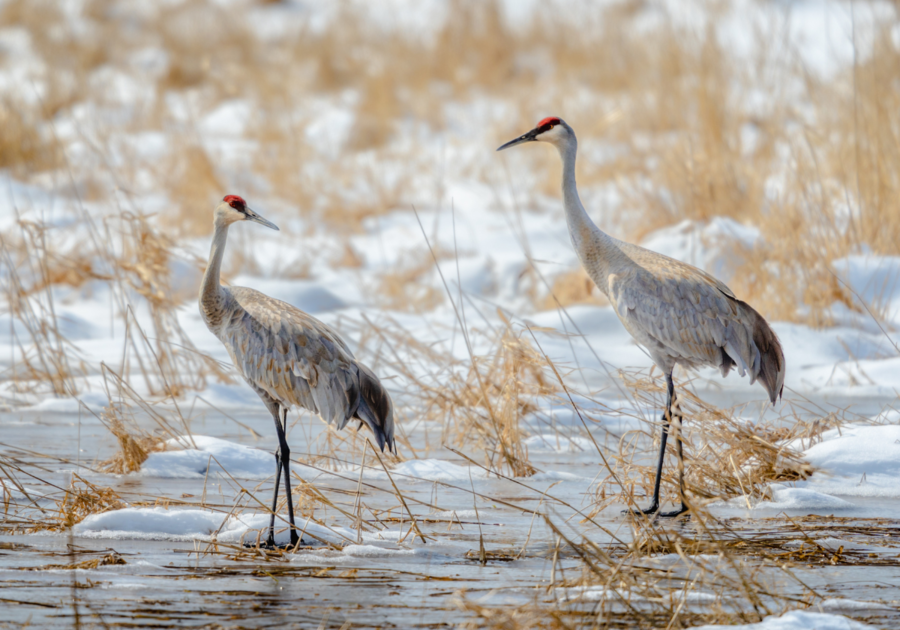When people think of Nebraska they usually don't think of the second largest animal migration in North America, a spectacular sight of 600,000 cranes descending upon the Platte River. If you wanted to watch the magnificent wildebeest migration in Kenya you'd need at least two flights, a hotel, a car and a huge chunk of change. If you want to see the crane migration you just need to hop in your car and drive to Grand Island, NE, about a 1.5 hour drive. There is one more week of "crane season."
| When to Visit and What Time to Go |
The cranes arrive every spring from late February to early April and their population typically peaks at the end of March. The majority of the birds arriving are sandhill cranes and they are nearly seven feet across.
Timing is everything with sandhill cranes. The best time of day to see the cranes is just after sunrise and the hour before sunset; however, visits to just about anywhere in the area will result in a crane spotting.
| Where to Go |
Guided tours are available but not necessary to see the sandhill cranes. There are great public viewing areas that are free. To see those click here. If you have young children this may be the best choice as many of the guided tours are not available to children under the age of 10.
If you have children over the age of 12, the Crane Trust, 20 minutes from Grand Island, offers many different kinds of guided tours, photography workshops, hiking biking and kayaking. Most of their tours are only people over the age of 12. If you have younger children you can still enjoy the animal display room, foot bridges and hiking trails. Monday – Saturday, 9:00am – 4:00pm. Trail hours vary to protect roosting and/or loafing cranes in the area.
The Rowe Sanctuary has free admission and is open seven days a week, 9:00 a.m. - 5:00 p.m., during Crane Season. It is just outside Kearney, NE and has over 1,300 acres of river habitat and wetlands. There is also an educational visitor center and multiple viewing blinds. Children under the age of 10 are not allowed in viewing blinds on the Guided Crane Viewing Experiences at the Rowe Sanctuary.
Head over to Fort Kearny State Recreation Area to see great over-river viewing of the cranes. View the sandhill cranes from the Fort Kearny Hike-Bike trail bridge located on the east side of the park. It is .3 miles from the parking lot. Get to the bridge at least half hour before sunrise and sunset for the best view. It is $6/car to enter.
There are two public viewing deck locations on the Platte River provided by the Central Platte Natural Resources District (CPNRD).
• Richard Plautz Crane Viewing Site: 1.5mi south of I-80 Exit 285 (Gibbon)
• Alda Crane Viewing Site: 2mi south of I-80 Exit 305 (Alda)
You'll want to arrive 30-60 minutes before sunrise and sunset. On good weather days you will more than likely be sharing the deck with others so be sure to be courteous!
| What to Bring and Not Bring, The Dos and Don'ts of Bird Watching |
Going Out in the Early Morning? What to Wear:
- Dress in layers (it can be 20 degrees in the morning and 75 degrees in the afternoon)
- Winter coat
- Boots/shoes along with wool socks (if you are walking through a marsh-your feet can get wet)
- Mittens or gloves and a hat
- Avoid brightly colored or white clothing especially if viewing from a blind
What Not to Bring:
- Your Pet
- A Camera with a flash
- Flashlights
What To Bring:
- Bincoulars
- Camera (no flash)
- Patience (the birds will take off and land when they want, not when people want them to)
Bird Watching Etiquette.
Sandhill cranes will often hunt for and eat insects in cornfields. You can find them all over. If you see a sandhill crane in a cornfield:
- Stay in your car and use it as a blind.
- Do not attempt to approach cranes.
- Drive onto the shoulder; don't stop in the middle of the road.
- Never cross a fence or open a cattle gate without the owner’s permission.
- Stay on county roads; do not drive on farm roads (that is private property)



